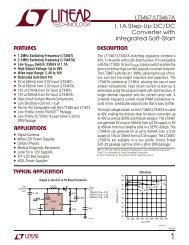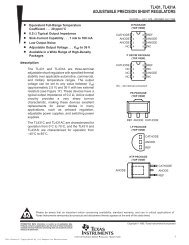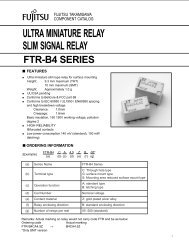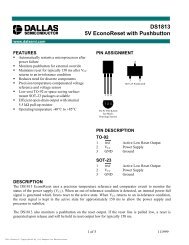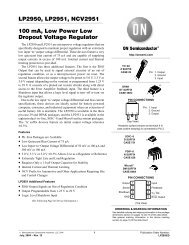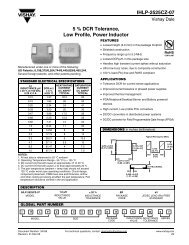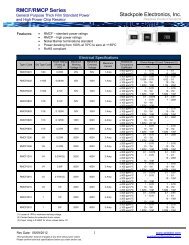LTC2051/LTC2052 Dual/Quad Zero-Drift Operational Amplifiers ...
LTC2051/LTC2052 Dual/Quad Zero-Drift Operational Amplifiers ...
LTC2051/LTC2052 Dual/Quad Zero-Drift Operational Amplifiers ...
Create successful ePaper yourself
Turn your PDF publications into a flip-book with our unique Google optimized e-Paper software.
<strong>LTC2051</strong>/<strong>LTC2052</strong><br />
APPLICATIO S I FOR ATIO<br />
Shutdown<br />
U W U U<br />
The <strong>LTC2051</strong> includes a shutdown pin in the 10-lead<br />
MSOP. When this active low pin is high or allowed to float,<br />
the device operates normally. When the shutdown pin is<br />
pulled low, the device enters shutdown mode; supply<br />
current drops to 3μA, all clocking stops and the output<br />
assumes a high impedance state.<br />
Clock Feedthrough, Input Bias Current<br />
The <strong>LTC2051</strong>/<strong>LTC2052</strong> use autozeroing circuitry to achieve<br />
an almost zero DC offset over temperature, common<br />
mode voltage and power supply voltage. The frequency of<br />
the clock used for autozeroing is typically 7.5kHz. The<br />
term clock feedthrough is broadly used to indicate visibility<br />
of this clock frequency in the op amp output spectrum.<br />
There are typically two types of clock feedthrough in<br />
autozeroed op amps like the <strong>LTC2051</strong>/<strong>LTC2052</strong>.<br />
The first form of clock feedthough is caused by the settling<br />
of the internal sampling capacitor and is input referred;<br />
that is, it is multiplied by the closed-loop gain of the op<br />
amp. This form of clock feedthrough is independent of the<br />
magnitude of the input source resistance or the magnitude<br />
of the gain setting resistors. The <strong>LTC2051</strong>/<strong>LTC2052</strong> have<br />
a residue clock feedthrough of less than 1μV RMS input<br />
referred at 7.5kHz.<br />
The second form of clock feedthrough is caused by the<br />
small amount of charge injection occurring during the<br />
sampling and holding of the op amps input offset voltage.<br />
The current spikes are multiplied by the impedance seen<br />
at the input terminals of the op amp, appearing at the<br />
output multiplied by the closed-loop gain of the op amp.<br />
To reduce this form of clock feedthrough, use smaller<br />
valued gain setting resistors and minimize the source<br />
resistance at the input. If the resistance seen at the inputs<br />
is less than 10k, this form of clock feedthrough is less<br />
than 1μV RMS input referred at 7.5kHz, or less than the<br />
amount of residue clock feedthrough from the first form<br />
previously described.<br />
Placing a capacitor across the feedback resistor reduces<br />
either form of clock feedthrough by limiting the bandwidth<br />
of the closed-loop gain.<br />
Input bias current is defined as the DC current into the<br />
input pins of the op amp. The same current spikes that<br />
cause the second form of clock feedthrough previously<br />
described, when averaged, dominate the DC input bias<br />
current of the op amp below 70°C.<br />
At temperatures above 70°C, the leakage of the ESD<br />
protection diodes on the inputs increase the input bias<br />
currents of both inputs in the positive direction, while the<br />
current caused by the charge injection stays relatively<br />
constant. At elevated temperatures (above 85°C) the<br />
leakage current begins to dominate and both the negative<br />
and positive pin’s input bias currents are in the positive<br />
direction (into the pins).<br />
Input Pins, ESD Sensitivity<br />
ESD voltages above 700V on the input pins of the op amp<br />
will cause the input bias currents to increase (more DC<br />
current into the pins). At these voltages, it is possible to<br />
damage the device to a point where the input bias current<br />
exceeds the maximums specified in this data sheet.<br />
TYPICAL APPLICATIO<br />
The dual chopper op amp buffers the inputs of A1 and<br />
corrects its offset voltage and offset voltage drift. With the<br />
RC values shown, the power-up warm-up time is typically<br />
20 seconds. The step response of the composite amplifier<br />
does not present settling tails. The LT ® 1677 should be<br />
used when extremely low noise, V OS and V OS drift are<br />
U<br />
needed and the input source resistance is low. (For instance<br />
a 350Ω strain gauge bridge.) The LT1012 or<br />
equivalent should be used when low bias current (100pA)<br />
is also required in conjunction with DC to 10Hz low noise,<br />
low V OS and V OS drift. The measured typical input offset<br />
voltages are less than 1μV.<br />
8<br />
20512fc



